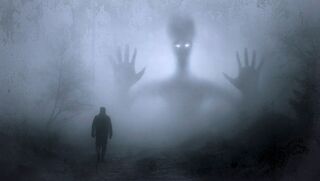Dreaming
Morbid Curiosity in Your Dreams
We experience morbid curiosity in waking life, but what about in our dreams?
Posted January 26, 2022 Reviewed by Gary Drevitch
Key points
- Morbid curiosity can be voluntary or involuntary.
- Threats in the real world, like the pandemic, can increase morbid curiosity.
- Nightmares are often examples of involuntary morbid curiosity.
I’ve written a lot about morbid curiosity in daily life — for example, how it relates to personality or anxiety. But, being the morbidly curious creatures that we humans are, our morbid curiosity doesn’t end when we shut our eyes at night.
One of the key ideas underlying morbid curiosity is that we simulate threatening scenarios in order to reduce the costs of learning threat-related information while retaining many of the benefits. We can watch a horror movie, play a scary video game, or engage in thrilling play as a way of exposing ourselves to analogues of dangerous situations. Cognitively playing with threatening simulations can teach us behavioral and emotional strategies for dealing with dangerous situations.
One way of looking at morbid curiosity is to split it into two types: voluntary and involuntary. Voluntary morbid curiosity involves actively searching for threat-related information. Watching a horror movie or listening to a true-crime podcast would be examples of voluntary morbid curiosity. Involuntary morbid curiosity occurs when we pay attention to a dangerous event or a simulation of a dangerous event that occurs without us having sought it out — for example, turning your head to see a car wreck.
As it turns out, dreaming may be another way we are involuntarily morbidly curious.

Threat Simulation Theory of Dreaming
The Threat Simulation Theory of dreaming posits that a key function of dreaming is to run simulations of threatening scenarios. These involuntary simulations allow our brains to rehearse threat recognition and avoidance behaviors while we sleep, improving our implicit responses to real threats when we are awake. Sometimes the threat in dreams may be very literal — a person chasing you through the woods. Other times, the aggressor may be more metaphorical — a large monster chasing you through the woods. However, both dreams follow a typical threat-simulation script of being chased.
First formulated in 2000 by Antti Revonsuo, the Threat Simulation Theory has stacked up quite a bit of evidence in its favor. According to some studies, nearly 3 out of every 4 adult dreams include at least one threatening event. Some of the most common categories of threats in dreams include aggression, failures, and accidents. In most cases, these dream threats occur to the dreamer. Dreams with high threat content, such as nightmares, are also more likely to be remembered after waking up. This might allow the threat-related scenarios to not only be implicitly rehearsed, but also consciously considered after waking up and shared with others.
A key proposition of the Threat Simulation Theory is that real threats should more strongly activate the threat management system. This would, in turn, lead to an increased prevalence of threats in dreams. The data seem to support this. For example, children who have experienced trauma are more than twice as likely to experience threats in their dreams. These dream threats are also more likely to include aggression and be a threat to their life. Increased daily stress, which might be associated with increased daily threat-perception, also predicts greater instances of nightmares. Relatedly, people who are more likely to experience anxiety — those who score high in the trait of neuroticism — report a higher frequency of threats in dreams. Interestingly, anxious people are also more likely to be morbidly curious in waking life.

COVID-19 and Dreaming
Because of its novelty and ubiquity, the COVID-19 pandemic has offered a unique way to test a variety of scientific hypotheses related to threat. The increased activation of the threat management system due to COVID-19 may have triggered morbid curiosity and increased threat simulation in many people. For example, the pandemic-themed movie Contagion became one of the most popular movies in the world in March 2020. People felt drawn to a fictional simulation of a pandemic when a real pandemic became a salient threat. But it wasn't just pandemic movies that skyrocketed in popularity: Horror movies secured a larger share of the box office in 2020 and 2021 than in any other year in history. In fact, the horror genre doubled its average box-office share during the pandemic.
As it turns out, people weren’t just experiencing increased threat simulations during the day. They were also experiencing increased involuntary threat simulation at night. The early months of the COVID-19 pandemic saw an increase in nightmares, of which many were pandemic-themed. While being chased or experiencing aggression were still common themes, people were now having nightmares about things like disease management, isolation, and sickness. Those who were more stressed about the pandemic also reported more threat-related and pandemic-specific dreams.
Morbidly Curious 24/7
It’s certainly true that some people are more voluntarily morbidly curious than others. Some people are more likely than others to seek out horror movies, listen to true crime podcasts, or watch violent sports. The studies I’ve conducted on morbid curiosity usually show a normal distribution of trait morbid curiosity. However, involuntary morbid curiosity is a different story. It can be influenced by anxiety and real-world threats, but nearly all of us experience it — both in waking life and in our dreams.
To see how morbidly curious you are, you can take the test here.
References
Scrivner, C. (2021). The psychology of morbid curiosity: Development and initial validation of the morbid curiosity scale. Personality and Individual Differences, 183, 111139.
Valli, K., Revonsuo, A., Pälkäs, O., Ismail, K. H., Ali, K. J., & Punamäki, R. L. (2005). The threat simulation theory of the evolutionary function of dreaming: Evidence from dreams of traumatized children. Consciousness and cognition, 14(1), 188-218.
Valli, K., & Revonsuo, A. (2009). The threat simulation theory in light of recent empirical evidence: a review. The American journal of psychology, 17-38.
Schredl, M., & Bulkeley, K. (2020). Dreaming and the COVID-19 pandemic: A survey in a US sample. Dreaming, 30(3), 189.
Scarpelli, S., Alfonsi, V., Mangiaruga, A., Musetti, A., Quattropani, M. C., Lenzo, V., ... & Franceschini, C. (2021). Pandemic nightmares: Effects on dream activity of the COVID‐19 lockdown in Italy. Journal of sleep research, e13300.


